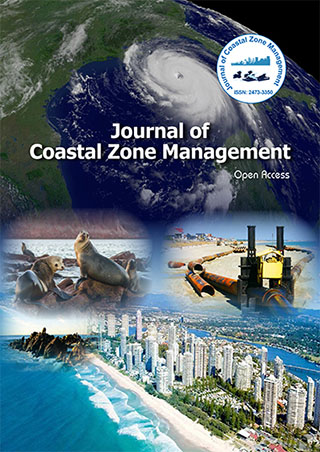Indexed In
- SafetyLit
- RefSeek
- Hamdard University
- EBSCO A-Z
- OCLC- WorldCat
- Publons
Useful Links
Share This Page
Journal Flyer

Open Access Journals
- Agri and Aquaculture
- Biochemistry
- Bioinformatics & Systems Biology
- Business & Management
- Chemistry
- Clinical Sciences
- Engineering
- Food & Nutrition
- General Science
- Genetics & Molecular Biology
- Immunology & Microbiology
- Medical Sciences
- Neuroscience & Psychology
- Nursing & Health Care
- Pharmaceutical Sciences
Perspective - (2022) Volume 25, Issue 10
Anthropogenic Pressure along the Coast and its Importance
Alex Chris*Received: 04-Oct-2022, Manuscript No. JCZM-22-18651; Editor assigned: 06-Oct-2022, Pre QC No. JCZM-22-18651 (PQ); Reviewed: 21-Oct-2022, QC No. JCZM-22-18651; Revised: 31-Oct-2022, Manuscript No. JCZM-22-18651 (R); Published: 08-Nov-2022, DOI: 10.35248/2473-3350.22.25.528
Description
One of the largest environmental problems of our day is human effect on coastal ecosystems. Understanding the depth and severity of species and habitat degradation necessitates a longterm outlook that takes into account historical data from a variety of sources, including local newspapers. By examining evidence of anthropogenic impacts in historical newspapers that have been digitally preserved and span 167 years and are accessible from the Brazilian Digital Newspapers and Periodicals Library, we here provide a new contribution to the historical ecology of marine organisms along the Brazilian coast. Prior to the start of scientific research and the gathering of data on fisheries landings in the area, in the 19th century, we discovered evidence of anthropogenic consequences related to overfishing and by catch.
Agriculture, animal husbandry, including aquaculture, fisheries, tourism, development, shipping, industrial development, and mining were the key economic sectors. Land reclamation, damming, draining, and water extraction are some examples of specific human activity. Other activities include dredging, logging in the case of mangroves, subsistence hunting, and oil and gas extraction. Ponds are built for aquaculture and salt extraction. The article's coastal wetlands surround river mouth systems, estuaries, deltas, and other transitional waters, includes shallow, semi-enclosed coastal systems like bays and coastal areas.
They consist of mudflats, sea grass meadows, saltmarshes, and mangrove swamps, among other types of habitat. The article uses examples of wetlands from tropical, temperate, and arctic climates to highlight the primary direct stresses The wetlands were chosen to provide a wide range of variety, including both very vast wetlands (such as those in the Mekong Delta) and considerably smaller ones In tropical wetlands, there are additionally changes in the ecosystem, such as the disappearance of mangrove trees, sea grass, and saltmarsh plants. Changes to the composition and operation of wetland ecosystems have an impact on often-underappreciated ecosystem services.
The decrease of ecosystem services affects both human wellbeing and the ability of coastal wetlands to control climate change. Indirect pressures like sea level rises further increase these effects and multi-stressors Limited average population concentrations have been detected along the Arctic and Antarctic shores. Martini et al. have examined the growth, composition, and zoning of coastal wetlands in the northern Polar region .Although there is an increase in economic activity, the residents continue to engage in certain traditional pastimes. In contrast to northern Norway, Iceland, or major urban areas like Southern Russia, a high percentage of small towns on the polar shores of Alaska, northern Canada, Greenland, and parts of Russia have mixed cash and subsistence cultures.
Industrial infrastructure is more substantial in areas with highly established economies, such as the Prudhoe Bay oilfield on the Alaskan North Slope Because of the small populations, anthropogenic direct impacts on coastal wetlands are often modest or local. Pressures from shipping, tourism, commercial fishing, hydrocarbon exploration and extraction, and mining operations will increase as a result of the disappearance of sea ice and the ensuing rapid increase in traffic along Arctic shores. Globalization's economic growth has fueled human activity and pressures that are accelerating changes in the environment, including a steady decline in sea ice and permafrost degradation The Mackenzie-Beaufort region is significantly more affected by indirect pressures from global emissions and climate change than it is by direct pressures. These indirect pressures include: accelerated coastal erosion; reduced snowfall; earlier and more rapid ice breakup in the Mackenzie delta; lower sea level; reduced sea ice; increased open water in the Beaufort Sea; increased wave energy with expanded open-water fetch; increased frequency and reach of storm surges; and reduced sea level.
Growth in human population and economic development are factors that contribute to the deterioration and disappearance of coastal wetlands, according to the Millennium Ecosystem Assessment. According to the Millennium Ecosystem Assessment, anthropogenic degradation and wetland loss were primarily caused by changes in land use, the building of infrastructure, the removal of water, eutrophication and pollution, overharvesting of commercial species and overexploitation of natural resources, as well as the introduction of non-native species. That the enlargement of the human population and the advancement of the economy cause the loss and degradation of coastal wetlands. Introduction of non-native species due to anthropogenic factors the two main human activities that put pressure on coastal wetlands are I land reclamation and conversion to agriculture, aquaculture, ports, and urban areas, and building of dams, dykes, polders, drainage channels, and other man-made structures.
Citation: Chris A (2022) Anthropogenic Pressure along the Coast and its Importance. J Coast Zone Manag. 25:528.
Copyright: © 2022 Chris A. This is an open-access article distributed under the terms of the Creative Commons Attribution License, which permits unrestricted use, distribution, and reproduction in any medium, provided the original author and source are credited.
